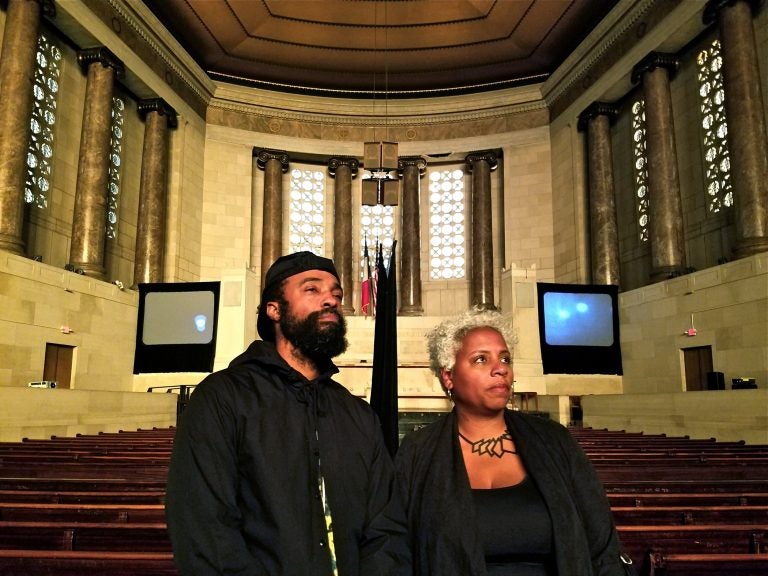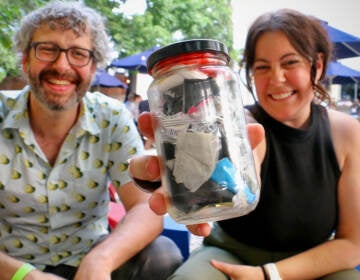At Girard College, ‘Back and Song’ showcases forgotten history of African healing arts
Philadelphia Contemporary commissioned Bradford Young and Elissa Blount Moorehead to make visual poetry out of traditional African wellness practices.
Listen 1:53
Bradford Young and Elissa Blount Moorhead stand in the Girard College chapel with their video installation, 'Back and Song.' (Peter Crimmins/WHYY)
The chapel at Girard College is not really a movie theater. Even when covered, it’s ornately carved windows let in too much afternoon sunlight. Darker images – many of the images in “Back and Song” are very dark – become hard to decipher.
On the other hand, “Back and Song” is not really a movie. It’s an installation of moving images on four separate screens. Two screens are on either side of the chapel altar; two screens in the center aisle face sideways, each turned outward. The arrangement makes it impossible to see all four screens at once.
The images are archival footage of various types of African and African American healing practices, from tribal ritual dance to dietary supplements hawked on TV infomercials. The installation broadly interprets culturally specific healing practices to include dance and music.
The film project by Bradford Young and Elissa Blount Moorhead folds spiritual and physical healing into the same acts.
“We needed to assure ourselves and the people we are in conversation with, that the way you move and the way you engage with the ailment by using your body as a healing device is legitimate,” said Young. “It works.”
The four-channel film sequence is about 20 minutes long, looping constantly. Although it feels like a documentary in that it consists of archival footage and original portraiture, it does not explain itself like a documentary. There is no distinct narrative arc and nothing is identified textually.
“It’s not only not a documentary, it’s not literal by any stretch,” said Nato Thompson, artistic director of Philadelphia Contemporary, which is presenting the work.
“But there is a lot of meat on the bone,” he said.
Relying on images over words, the piece traces healing powers that are inherent in a particular culture.
It also shows that those healing powers may have been forgotten by the dominant culture, but have survived nevertheless.
“The healing practices were part of dancing. Dance, healing, wellness were all one thing,” said Thompson. “You start thinking about the ways in which we have historically separated those forms: that the body and culture have become separated from consideration of wellness.”
“Back and Song” shows old archeological footage of members of an African tribe engaged a ritual dance. The dancers appear to be in a trance. It buts that up against a frenetic performance by improvisational jazz pianist Cecil Taylor (who died last year at 89).
Young equates Taylor’s playing, seemingly without recognizable structure, with tribal dance: both disregard Western thought about music and healing.
“It’s a highly intellectual practice,” he said of Taylor’s playing. “But because it’s free it doesn’t have to adhere to the judgment of those within the ivory tower cultural context.”
Young shot cinematic portraits of contemporary healers. Occupying the center screens of the room, the images of intentionally dark such that the dark skin of the subjects can blur into the shadows of the image.
The people are not identified. Many of them prefer to be anonymous.
“They are filmmakers, midwives, healers, death doulas,” said Young. “They do work in the community that is given for free, but overlooked because of the way they are adorned.”
The filmmakers put themselves squarely in that culturally specific healing tradition. As filmmakers, they have navigated a profession that does not always value their African American culture: film projects are often about African Americans, but rarely explicitly for them.
Moorehead said making this film about healing practices was, itself, a healing art.
“There’s always a question of how you are going to present yourself, and to whom,” she said. “This is a demonstration to ourselves that we can operate with our back to those lenses.”
While they have been successful in the cinema industry — Young has worked on “Selma,” “Han Solo,” and was nominated for an Academy Award for his work on the film “Arrival” — the pair speak about the lack of resources for filmmaking specific to the African American community.
This project, commissioned by Philadelphia Contemporary in partnership with Thomas Jefferson University, allowed them to experiment with a cinematic form outside of the film industry that uses artistry to get at deep cultural issues.
“This is a hats-off to a new generation of filmmaking: I don’t ask permission. I can tell a story, build a narrative that is unique and special to my own cultural perspective,” said Young. “I don’t need to go through the channels of asking permission and raising money.”
WHYY is your source for fact-based, in-depth journalism and information. As a nonprofit organization, we rely on financial support from readers like you. Please give today.





